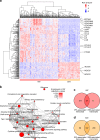Transcriptome Profiling of Adipose Tissue Reveals Depot-Specific Metabolic Alterations Among Patients with Colorectal Cancer
- PMID: 31225875
- PMCID: PMC6763280
- DOI: 10.1210/jc.2019-00461
Transcriptome Profiling of Adipose Tissue Reveals Depot-Specific Metabolic Alterations Among Patients with Colorectal Cancer
Abstract
Context: Adipose tissue inflammation and dysregulated energy homeostasis are key mechanisms linking obesity and cancer. Distinct adipose tissue depots strongly differ in their metabolic profiles; however, comprehensive studies of depot-specific perturbations among patients with cancer are lacking.
Objective: We compared transcriptome profiles of visceral adipose tissue (VAT) and subcutaneous adipose tissue (SAT) from patients with colorectal cancer and assessed the associations of different anthropometric measures with depot-specific gene expression.
Design: Whole transcriptomes of VAT and SAT were measured in 233 patients from the ColoCare Study, and visceral and subcutaneous fat area were quantified via CT.
Results: VAT compared with SAT showed elevated gene expression of cytokines, cell adhesion molecules, and key regulators of metabolic homeostasis. Increased fat area was associated with downregulated lipid and small molecule metabolism and upregulated inflammatory pathways in both compartments. Comparing these patterns between depots proved specific and more pronounced gene expression alterations in SAT and identified unique associations of integrins and lipid metabolism-related enzymes. VAT gene expression patterns that were associated with visceral fat area poorly overlapped with patterns associated with self-reported body mass index (BMI). However, subcutaneous fat area and BMI showed similar associations with SAT gene expression.
Conclusions: This large-scale human study demonstrates pronounced disparities between distinct adipose tissue depots and reveals that BMI poorly correlates with fat mass-associated changes in VAT. Taken together, these results provide crucial evidence for the necessity to differentiate between distinct adipose tissue depots for a correct characterization of gene expression profiles that may affect metabolic health of patients with colorectal cancer.
Copyright © 2019 Endocrine Society.
Figures

Similar articles
-
Metabolomics and transcriptomics identify pathway differences between visceral and subcutaneous adipose tissue in colorectal cancer patients: the ColoCare study.Am J Clin Nutr. 2015 Aug;102(2):433-43. doi: 10.3945/ajcn.114.103804. Epub 2015 Jul 8. Am J Clin Nutr. 2015. PMID: 26156741 Free PMC article. Clinical Trial.
-
The human visceral fat depot has a unique inflammatory profile.Obesity (Silver Spring). 2010 May;18(5):879-83. doi: 10.1038/oby.2010.22. Obesity (Silver Spring). 2010. PMID: 20186138
-
Gene expression regional differences in human subcutaneous adipose tissue.BMC Genomics. 2017 Feb 23;18(1):202. doi: 10.1186/s12864-017-3564-2. BMC Genomics. 2017. PMID: 28231762 Free PMC article.
-
Two Faces of White Adipose Tissue with Heterogeneous Adipogenic Progenitors.Diabetes Metab J. 2019 Dec;43(6):752-762. doi: 10.4093/dmj.2019.0174. Diabetes Metab J. 2019. PMID: 31902145 Free PMC article. Review.
-
Visceral adiposity and inflammatory bowel disease.Int J Colorectal Dis. 2021 Nov;36(11):2305-2319. doi: 10.1007/s00384-021-03968-w. Epub 2021 Jun 9. Int J Colorectal Dis. 2021. PMID: 34104989 Review.
Cited by
-
Association between Periodontal Condition and Fat Distribution in Japanese Adults: A Cross-Sectional Study Using Check-Up Data.Int J Environ Res Public Health. 2023 Jan 17;20(3):1699. doi: 10.3390/ijerph20031699. Int J Environ Res Public Health. 2023. PMID: 36767065 Free PMC article.
-
A hint for the obesity paradox and the link between obesity, perirenal adipose tissue and Renal Cell Carcinoma progression.Sci Rep. 2022 Nov 19;12(1):19956. doi: 10.1038/s41598-022-24418-9. Sci Rep. 2022. PMID: 36402906 Free PMC article.
-
Putative positive role of inflammatory genes in fat deposition supported by altered gene expression in purified human adipocytes and preadipocytes from lean and obese adipose tissues.J Transl Med. 2020 Nov 12;18(1):433. doi: 10.1186/s12967-020-02611-6. J Transl Med. 2020. PMID: 33183332 Free PMC article.
-
Multi-omics Analysis Reveals Adipose-tumor Crosstalk in Patients with Colorectal Cancer.Cancer Prev Res (Phila). 2020 Oct;13(10):817-828. doi: 10.1158/1940-6207.CAPR-19-0538. Epub 2020 Jul 12. Cancer Prev Res (Phila). 2020. PMID: 32655010 Free PMC article.
-
MRI radiomics features of mesorectal fat can predict response to neoadjuvant chemoradiation therapy and tumor recurrence in patients with locally advanced rectal cancer.Eur Radiol. 2022 Feb;32(2):971-980. doi: 10.1007/s00330-021-08144-w. Epub 2021 Jul 29. Eur Radiol. 2022. PMID: 34327580 Free PMC article.
References
-
- Long MT, Fox CS. The Framingham Heart Study—67 years of discovery in metabolic disease. Nat Rev Endocrinol. 2016;12(3):177–183. - PubMed
-
- Murphy N, Jenab M, Gunter MJ. Adiposity and gastrointestinal cancers: epidemiology, mechanisms and future directions. Nat Rev Gastroenterol Hepatol. 2018;15(11):659–670. - PubMed
Publication types
MeSH terms
Grants and funding
LinkOut - more resources
Full Text Sources
Medical
Research Materials

